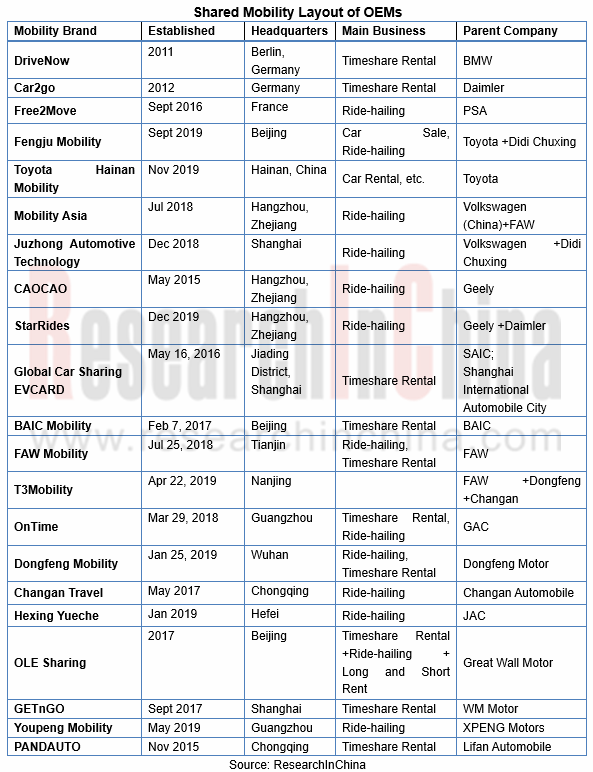Shared Mobility Industry Research--Autonomous Driving Leads Shared Mobility 3.0
The global shared mobility industry is experiencing a hard time. It is since 2019 that shared mobility enterprises have been exposed to financial fragility and have closed down one after another amid a nosedive in financing amount and rounds. The COVID-19 pandemic makes things worse. Shared mobility companies such as Uber and Lyft have cut jobs, while many automakers and Robotaxi companies have dabbled in the shared mobility market.
Tan Yi from GoFun believes that Shared Mobility 1.0 refers to the current public transit system, 2.0 means the new formats -- ride-hailing and timeshare rental occurring now, and 3.0 represents the application of autonomous driving in the future.
Shared mobility is closely related to autonomous driving. It is difficult for both of them to make money at this stage.
By 2030, the global Robotaxi fleet market will be worth at least US$2 trillion annually, 12% of new cars will be sold to Robotaxi fleets globally, and 26 million Robotaxis will be in operation, as estimated by UBS Evidence Lab.
To have a bite of the future shared mobility market, the giants have offered subsidies to squeeze small and medium-sized mobility firms. Only the full exertion of autonomous driving can make the shared mobility market scale up, but the current immature autonomous driving technology, regulations and business models makes the goal impossible.
The shared mobility market is the battlefield of vibrant players who still need fight in alliance. WAYMO has tested Robotaxi for ten years. BMW has been groping for shared mobility business for almost a decade, but it eventually allied with Daimler to push on deeper cooperation on autonomous driving and shared mobility.

A study by General Motors shows that the cost of shared mobility will be slashed from $ 3 / mile to $1 / mile through autonomous driving by 2025, thereby diluting the operation cost through a large scale. After 2030, the mobility mileage of Robotaxis will constitute 75% of the total.


That is to say, autonomous driving will not give much impetus to shared mobility until 2025. From now on, it is a challenge for ambitious companies to make a layout in just five years. Looking back at the players’ Robotaxi trials in 2019, we can see that fiercer rivalry is under way.
Trial Operation of Robotaxi
Three major forces are competing for the Robotaxi market, including:
(1) Didi, Uber, Lyft and other mobility platforms;
(2) Waymo, Aptiv, Baidu, Pony.ai and other Robotaxi solution providers;
(3) OEMs. Tesla plans to launch a Robotaxi network involving over a million Robotaxis on the road. Waymo has secured US$3 billion in financing for enlarging the Robotaxi test fleet. Baidu announced in April 2020 the availability of China's first Robotaxi services which are being offered on mobile apps to the public.

Although a few giants and top Robotaxi startups are making long-term plans, it is still too early for most automakers, most of which have launched their own mobility service brands successively and made attempts in the lucrative but fiercely contested mobility market.

Autonomous Driving Domain Controller and Central Computing Unit (CCU) Industry Report, 2025
Research on Autonomous Driving Domain Controllers: Monthly Penetration Rate Exceeded 30% for the First Time, and 700T+ Ultrahigh-compute Domain Controller Products Are Rapidly Installed in Vehicles
L...
China Automotive Lighting and Ambient Lighting System Research Report, 2025
Automotive Lighting System Research: In 2025H1, Autonomous Driving System (ADS) Marker Lamps Saw an 11-Fold Year-on-Year Growth and the Installation Rate of Automotive LED Lighting Approached 90...
Ecological Domain and Automotive Hardware Expansion Research Report, 2025
ResearchInChina has released the Ecological Domain and Automotive Hardware Expansion Research Report, 2025, which delves into the application of various automotive extended hardware, supplier ecologic...
Automotive Seating Innovation Technology Trend Research Report, 2025
Automotive Seating Research: With Popularization of Comfort Functions, How to Properly "Stack Functions" for Seating?
This report studies the status quo of seating technologies and functions in aspe...
Research Report on Chinese Suppliers’ Overseas Layout of Intelligent Driving, 2025
Research on Overseas Layout of Intelligent Driving: There Are Multiple Challenges in Overseas Layout, and Light-Asset Cooperation with Foreign Suppliers Emerges as the Optimal Solution at Present
20...
High-Voltage Power Supply in New Energy Vehicle (BMS, BDU, Relay, Integrated Battery Box) Research Report, 2025
The high-voltage power supply system is a core component of new energy vehicles. The battery pack serves as the central energy source, with the capacity of power battery affecting the vehicle's range,...
Automotive Radio Frequency System-on-Chip (RF SoC) and Module Research Report, 2025
Automotive RF SoC Research: The Pace of Introducing "Nerve Endings" such as UWB, NTN Satellite Communication, NearLink, and WIFI into Intelligent Vehicles Quickens
RF SoC (Radio Frequency Syst...
Automotive Power Management ICs and Signal Chain Chips Industry Research Report, 2025
Analog chips are used to process continuous analog signals from the natural world, such as light, sound, electricity/magnetism, position/speed/acceleration, and temperature. They are mainly composed o...
Global and China Electronic Rearview Mirror Industry Report, 2025
Based on the installation location, electronic rearview mirrors can be divided into electronic interior rearview mirrors (i.e., streaming media rearview mirrors) and electronic exterior rearview mirro...
Intelligent Cockpit Tier 1 Supplier Research Report, 2025 (Chinese Companies)
Intelligent Cockpit Tier1 Suppliers Research: Emerging AI Cockpit Products Fuel Layout of Full-Scenario Cockpit Ecosystem
This report mainly analyzes the current layout, innovative products, and deve...
Next-generation Central and Zonal Communication Network Topology and Chip Industry Research Report, 2025
The automotive E/E architecture is evolving towards a "central computing + zonal control" architecture, where the central computing platform is responsible for high-computing-power tasks, and zonal co...
Vehicle-road-cloud Integration and C-V2X Industry Research Report, 2025
Vehicle-side C-V2X Application Scenarios: Transition from R16 to R17, Providing a Communication Base for High-level Autonomous Driving, with the C-V2X On-board Explosion Period Approaching
In 2024, t...
Intelligent Cockpit Patent Analysis Report, 2025
Patent Trend: Three Major Directions of Intelligent Cockpits in 2025
This report explores the development trends of cutting-edge intelligent cockpits from the perspective of patents. The research sco...
Smart Car Information Security (Cybersecurity and Data Security) Research Report, 2025
Research on Automotive Information Security: AI Fusion Intelligent Protection and Ecological Collaboration Ensure Cybersecurity and Data Security
At present, what are the security risks faced by inte...
New Energy Vehicle 800-1000V High-Voltage Architecture and Supply Chain Research Report, 2025
Research on 800-1000V Architecture: to be installed in over 7 million vehicles in 2030, marking the arrival of the era of full-domain high voltage and megawatt supercharging.
In 2025, the 800-1000V h...
Foreign Tier 1 ADAS Suppliers Industry Research Report 2025
Research on Overseas Tier 1 ADAS Suppliers: Three Paths for Foreign Enterprises to Transfer to NOA
Foreign Tier 1 ADAS suppliers are obviously lagging behind in the field of NOA.
In 2024, Aptiv (2.6...
VLA Large Model Applications in Automotive and Robotics Research Report, 2025
ResearchInChina releases "VLA Large Model Applications in Automotive and Robotics Research Report, 2025": The report summarizes and analyzes the technical origin, development stages, application cases...
OEMs’ Next-generation In-vehicle Infotainment (IVI) System Trends Report, 2025
ResearchInChina releases the "OEMs’ Next-generation In-vehicle Infotainment (IVI) System Trends Report, 2025", which sorts out iterative development context of mainstream automakers in terms of infota...